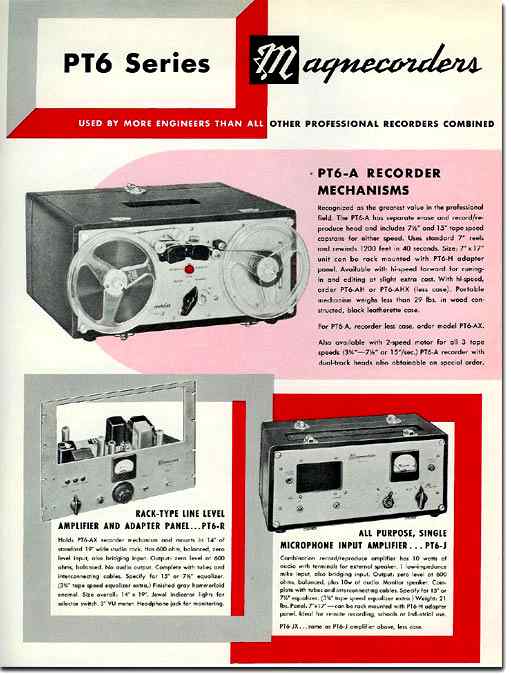Magnecord PT6-J audio amp
Magnecord PT6-J audio amp
Time for another tube audio amplifier. This Magnecord PT6-J is the amplifier part of a PT6 series Magnecord tape recorder setup from the late 1940s to about 1952.
The first two preamp tubes use DC for filaments. The amp has a built-in switched monitor speaker. Speaker output connections include both the typical screw terminal strip and a phone jack. The amp also includes a 600 ohm balanced line output, inverse feedback and a VU meter. Original price for the amp was $221.50. A 1952 catalog lists the price at $260. The 1952 Lafayette catalog has $248.00. This is an early version. A later variation, the PT6-JA, substituted a miniature 5879 for the first preamp tube.

I bought this amp at an auction. It was in its original black leatherette case. I did not know what was inside but assumed that it was probably an audio preamp of some sort. I was pleasantly surprised to find a full push-pull 6V6 amp inside that was fully functional and complete even without the tape recorder mechanism.
Repairs
I pulled the fuse and was dismayed to find a 20 amp car fuse inside. I replaced the fuse with a proper one. As usual, I did safety checks for any possible line to chassis leakage, for the proper level of resistance in the B+ lines and a check of the output transformer and speaker connection to verify a proper load on the output transformer. My initial very careful power up was stopped very quickly when the ammeter on my isolated variac pegged. Huh? A careful check revealed that line cord was shorted internally due to hardened and cracked insulation. That would probably explain the 20 amp fuse that sometime had tried. At least the short was not in the power transformer!
I replaced the power cord with a proper grounded 3 wire cord rewiring it to the modern standard of the line to fuse and then the power switch and the neutral directly to the power transformer.
Both the coupling capacitors and the main electrolytics needed to be replaced. The resistors in the phase inversion circuitry had increased in value and were replaced. The built-in monitor speaker had been replaced with one of the wrong size. It suffered a torn cone. I replaced it with a proper one. The low voltage copper-oxide rectifier for the preamp filaments had failed. Someone in the amp's past had substituted a pair of 6SC7 for the original 12SC7 pair and rewired the preamp filaments for AC. The amp worked fine with the AC on the filaments, but I wanted to feed the tube filaments with DC as intended. The 20 volt winding originally used for the filaments read 24 volts at no load with my line voltage. A modern replacement rectifier and electrolytic brought that up to 34 volts no load. Feeding that to the 12 volts filaments as originally wired in parallel would likely have burned out the filaments. I thought of rewiring the pair of 12SC7 filaments in series and using a dropping resistor or a 3 terminal regulator. However, I did not have 12SC7 tubes although I had plenty of the 6SC7 type. In the end, I opted to simply add a 6 volt filament transformer under the chassis and use that as the source for the rectifer and filter for 6 volts of DC filament power. It worked fine.
Performance
The little amp has lots of gain as would be expected for an amp that can directly handle input from a tape head by way of its matching transformer. It performed very well as an audio amp.
More information
Preservation sound has a web page describing the results of
using the PT6 as a 60 year old recorder system.
The Reel to Reel Texas website has lots more info and vintage ads for this Magnecord and its relatives.
Manual source
A manual for the near identical PT6-JA with schematic can be found the history of recording website.
More Audio systems
I have repaired and documented a number of other audio amplifiers and equipment.
A list and links to that audio equipment can be found here.
7-17-13
The Lafayette Surprise, Political Intrigue and Radio as published in the April 2013 Monitoring Times was the previous project on the website.